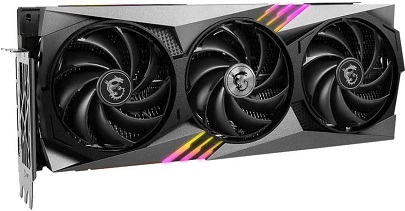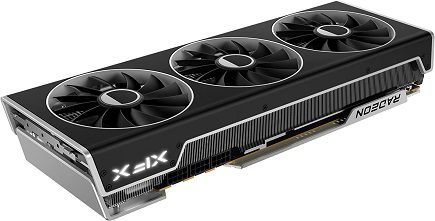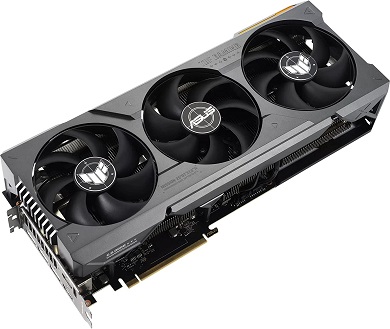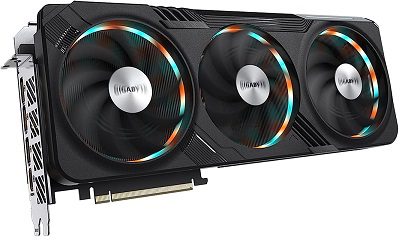If you use your computer for creative work, you must render many files, including 3D graphics, animations, videos, images, etc. And while you can render such files using your computer’s CPU, things can be done much faster if you are using one of the best GPUs for rendering given below that have been picked as per these factors:
- GPU Model: Before checking anything else, you should first check the GPU model since that allows you to compare different GPUs easily. A higher GPU model like the Nvidia RTX 4090 or RTX 4080 will perform better than the Nvidia RTX 3090 or the RTX 3080.
- Video Memory: But when it comes to comparing GPUs from different brands, then you should check their video memory. Usually, a GPU with higher video memory performs better. For example, a 24 GB GDDR6X GPU will perform much better than a 16 GB GDDR6 GPU.
- Clock Speed: Another great way to compare the performance of different GPUs for rendering is to check their clock speed. Generally, a GPU with a higher clock speed will offer better performance which is great for rendering. So, if you want the performance, you should go with a GPU with a clock speed of up to 2640 MHz instead of up to 1800 MHz clock speed.
Even though these are some of the most important factors regarding GPUs for rendering, there is still much more that you should check. Thus, all of the best GPUs for rendering given down below have all their major features and options given next to them. More importantly, you will also find an extensive “Buying Guide” and a few key FAQs for the best GPUs for rendering to easily select the best one for your needs.
Outline
ToggleBest GPUs for Rendering: Table
| Best GPUs for Rendering | GPU Model | Video Memory | Clock Speed | Buy Now |
|---|---|---|---|---|
| MSI GPU | Nvidia RTX 4090 | 24 GB GDDR6X | Up to 2610 MHz | Check On Amazon Check On Walmart |
| XFX Speedster GPU | AMD RX 7900 XTX | 24 GB GDDR6 | Up to 2615 MHz | Check On Amazon Check On Walmart |
| ASUS GPU | Nvidia RTX 4080 | 16 GB GDDR6X | Up to 2625 MHz | Check On Amazon Check On Walmart |
| PowerColor GPU | AMD RX 6950 XT | 16 GB GDDR6 | Up to 2435 MHz | Check On Amazon Check On Walmart |
| Gigabyte GPU | Nvidia RTX 4070 Ti | 12 GB GDDR6X | Up to 2640 MHz | Check On Amazon Check On Walmart |
| EVGA GPU | Nvidia RTX 3090 | 24 GB GDDR6X | Up to 1800 MHz | Check On Amazon Check On Walmart |
| ZOTAC GPU | Nvidia RTX 3080 | 10 GB GDDR6X | Up to 1725 MHz | Check On Amazon |
Best GPUs for Rendering Reviews
1. MSI GPU
MSI is a well-known brand for top-notch computer hardware, especially loved by gamers and those into rendering. In this regard, the GeForce RTX 4090 Tri Frozr 3 GPU tops this list as the most powerful option discussed. It boasts 24 GB GDR6X video memory, a blazing clock speed of up to 2610 MHz, and a whopping 16384 processing cores, ensuring exceptional performance.
This GPU features a 3-fan cooler and offers 3 x DisplayPort 1.4 and 1 x HDMI 2.1 ports. However, due to its high specifications, it has a hefty TDP of up to 450 watts. Fortunately, MSI includes a standard 3-year warranty, providing peace of mind for users.
Best Features:
- Comes with 24 GB GDDR6X video memory
- Supports up to 2610 MHz clock speeds
- Powered by 16384 CUDA cores
- Uses a 3-fan cooler design
- Includes 3 x DisplayPort 1.4 and 1 x HDMI 2.1 ports
- Rated TDP of up to 450 watts
- Backed by a 3-year warranty period
Pros:
- Top-of-the-line GPU for rendering with excellent performance numbers
- Quite amazing cooling performance considering the given performance numbers
- Includes multiple ports on the back for easily connecting multiple monitors
Cons:
- TDP rating is much higher than most other GPUs for rendering out there
Buy Now From Amazon Buy Now From Walmart
2. XFX Speedster GPU
If you’re searching for AMD GPU options, consider XFX as a reliable brand. The Speedster Merc310 AMD Radeon RX 7900 XTX GPU stands out for its value. We recommend it over the MSI model. Despite its lower price, this GPU offers 24 GB GDDR6 video memory and can reach clock speeds of up to 2615 MHz. With 6144 stream processors, it delivers top-notch performance for rendering tasks.
This high-end GPU features a 3 fan cooler design for efficient cooling. Unlike Nvidia GPUs, it also includes 2 x DisplayPort 2.1 and 1 x HDMI 2.1 ports, ensuring future compatibility. With a TDP of up to 355 watts, it balances power and performance well.
Best Features:
- Comes with 24 GB GDDR6 video memory
- Supports up to 2615 MHz clock speeds
- Powered by 6144 stream processors
- Uses a 3-fan cooler design
- Includes 2 x DisplayPort 2.1 and 1 x HDMI 2.1 ports
- Rated TDP of up to 355 watts
- Backed by a 5-year warranty period
Pros:
- Excellent value for money GPU for rendering thanks to a lower price tag
- Great performance numbers, along with a fairly low TDP rating
- Quite a long warranty period for amazing longevity and peace of mind
Cons:
- Does not use the faster GDDR6X memory, which is useful for memory-intensive tasks
Buy Now From Amazon Buy Now From Walmart
3. ASUS GPU
Asus offers a solid option with its TUF lineup of GPUs, providing high performance without breaking the bank. The TUF Gaming GeForce RTX 4080 boasts 16 GB GDDR6X video memory and a clock speed of up to 2625 MHz, along with 9728 CUDA cores for top-notch performance.
To keep things cool and running smoothly, Asus includes a 3-fan cooler with the GPU. It’s equipped with 3 DisplayPort 1.4 and 2 HDMI 2.1 ports, perfect for multi-monitor setups. Plus, its power consumption is kept relatively low, with a TDP of up to 320 watts. On the other hand, the GPU itself features a 3-fan cooler and offers 3 DisplayPort 1.4 and 1 HDMI 2.1 ports.
Best Features:
- Comes with 16 GB GDDR6X video memory
- Supports up to 2615 MHz clock speeds
- Powered by 9728 CUDA cores
- Uses a 3-fan cooler design
- Includes 3 x DisplayPort 1.4 and 2 x HDMI 2.1 ports
- Rated TDP of up to 320 watts
- Backed by a 3-year warranty period
Pros:
- Fairly high value for money GPU for rendering thanks to its amazing performance
- Runs fairly cool despite being a high-end GPU due to its 3-fan cooler
- Much more manageable TDP rating as compared to the RTX 4090 GPU
Cons:
- Lacks DisplayPort 2.1 connector despite being the latest generation GPU
Buy Now From Amazon Buy Now From Walmart
4. PowerColor GPU
The Red Devil AMD Radeon RX 6950 XT GPU from PowerColor is surprisingly impressive for its price. It boasts 16 GB GDDR6 video memory and can reach a clock speed of up to 2435 MHz. Even though it’s from a previous generation, it still packs a punch with 5120 stream processors, delivering fantastic performance.
On the physical side, it’s equipped with a 3-fan cooler to maintain optimal temperature. Its power consumption, with a TDP of up to 335 watts, matches other GPUs in its league. For connectivity, it offers 3 x DisplayPort 1.4 and 1 x HDMI 2.1 ports. However, it only comes with a 2-year warranty, which might be a drawback for some considering its affordability.
Best Features:
- Comes with 16 GB GDDR6 video memory
- Supports up to 2435 MHz clock speeds
- Powered by 5120 stream processors
- Uses a 3-fan cooler design
- Includes 3 x DisplayPort 1.4 and 1 x HDMI 2.1 ports
- Rated TDP of up to 335 watts
- Backed by a 2-year warranty period
Pros:
- One of the cheapest GPUs for rendering available out there for buyers on a budget
- Quite great performance numbers as it is a previous generation flagship GPU
- Decent cooling performance with a manageable TDP rating
Cons:
- Could have included a longer warranty period for peace of mind
Buy Now From Amazon Buy Now From Walmart
5. Gigabyte GPU
The Gigabyte GeForce RTX 4070 Ti Gaming OC GPU has 12 GB of video memory and a clock speed of up to 2640 MHz. It comes with 7680 CUDA cores, which is lower compared to others.
It’s equipped with a 3-fan cooler design, similar to higher-end options. Plus, it has a practical TDP of up to 285 watts since it’s not the most powerful GPU for rendering. On the back, there are 3 DisplayPort 1.4 and 1 HDMI 2.1 ports, which are useful. Also, it comes with a 4-year warranty, which is great considering the price.
Best Features:
- Comes with 12 GB GDDR6X video memory
- Supports up to 2640 MHz clock speeds
- Powered by 7680 CUDA cores
- Uses a 3-fan cooler design
- Includes 3 x DisplayPort 1.4 and 1 x HDMI 2.1 ports
- Rated TDP of up to 285 watts
- Backed by a 4-year warranty period
Pros:
- One of the coolest GPUs for rendering with its TDP rating and a 3-fan cooler
- Great warranty period for your peace of mind and amazing longevity
- Decent performance numbers, especially for the given price tag
Cons:
- Not comparable to other flagship GPU models for rendering larger projects
Buy Now From Amazon Buy Now From Walmart
6. EVGA GPU
EVGA is a top brand known for high-end GPUs, even if you’re considering previous-generation models for rendering. Take their GeForce RTX 3090 FTW3 Ultra GPU, for example. It boasts 24 GB GDDR6X video memory and a clock speed of up to 1800 MHz. Notably, it packs 10496 CUDA cores, among the highest available.
What sets it apart is its 3-fan cooler, ensuring optimal performance. This cooler handles the GPU’s 350-watt TDP rating effortlessly. Like most GPUs, it offers 3 x Display 1.4 and 1 x HDMI 2.1 ports for easy monitor connection. Plus, it comes with a standard 3-year warranty, matching similar options.
Best Features:
- Comes with 24 GB GDDR6X video memory
- Supports up to 2610 MHz clock speeds
- Powered by 16384 CUDA cores
- Uses a 3 fan cooler design
- Includes 3 x DisplayPort 1.4 and 1 x HDMI 2.1 ports
- Rated TDP of up to 450 watts
- Backed by a 3-year warranty period
Pros:
- Amazing performance numbers thanks to its high-end specifications
- One of the best-performing GPU coolers with a 3-fan design
- Standard connectivity options at the back for using multiple monitors
Cons:
- Quite an expensive GPU for rendering despite being a previous-generation model
Buy Now From Amazon Buy Now From Walmart
7. ZOTAC GPU
Zotac offers another solid option if you need a powerful and dependable GPU. The Gaming GeForce RTX 3080 Trinity OC GPU, while ranking last on our list of the best GPUs for rendering, still manages to impress. It’s a good choice for long-term use. In terms of performance, it boasts 10 GB GDDR6X video memory and a decent clock speed of up to 1725 MHz.
Despite being from the previous generation, it packs 8704 CUDA cores for impressive performance. Like most high-performance GPUs for rendering, it features a 3-fan cooler design. Additionally, it provides three DisplayPort 1.4 ports and one HDMI 2.1 port for versatile monitor connections. What’s more, it has a lower TDP of up to 320 watts compared to some other options. The best aspect is its 5-year warranty.
Best Features:
- Comes with 10 GB GDDR6X video memory
- Supports up to 1725 MHz clock speeds
- Powered by 8704 CUDA cores
- Uses a 3 fan cooler design
- Includes 3 x DisplayPort 1.4 and 1 x HDMI 2.1 ports
- Rated TDP of up to 320 watts
- Backed by a 5 year long warranty period
Pros:
- Class leading warranty period for excellent longevity and reliability
- Great performance numbers thanks to fast video memory and high CUDA core count
- Pretty great cooling numbers with the given cooler design and TDP rating
Cons:
- Average clock speed rating as compared with other GPUs for rendering
Buying Guide For The Best GPUs For Rendering
Apart from playing games, the GPU of your computer can also be used in creative applications for rendering purposes. This is made possible thanks to hardware acceleration being supported by most creative applications.
And if you also want to make your rendering process much faster, then you should get something like the best GPUs for rendering stated up above. With all of these best GPUs for rendering, you can also learn about their primary specifications and features. But if you want to learn further for selecting the perfect GPU, then make sure to check out this complete buying guide for the best GPUs for rendering:
1. GPU Model
When you are talking about GPUs for rendering, there are quite a lot of factors to consider which can make comparing them quite difficult. Therefore, you should first check the GPU model of a given graphics card since it is the easiest way to compare different GPUs.
As you would expect, a newer and higher GPU model will definitely perform than an older and entry-level GPU. So, if you want to compare GPUs for rendering within the same brand, you can simply go with higher-end models like the Nvidia RTX 4090 and RTX 4080 over the Nvidia RTX 3090 and RTX 3080, respectively.
2. Video Memory
However, since you will also want to compare GPUs from different brands, you will need to consider other GPU factors as well, such as the video memory of a given GPU. While checking the video memory of a GPU, you need to consider its capacity as well as the memory speed. Starting with the memory capacity, it is given in GB, which can include options like 10 GB, 12 GB, 16 GB, or even 24 GB video memory, where higher is always better. As for the video memory speeds, this rating is given as GDDR6 or GDDR6X, where GDDR6X offers better performance. So if you want the best possible performance, you should go with a 24 GB GDDR6X GPU.
3. Clock Speed
If you want to compare the performance of different GPUs for rendering, then you can also consider checking their clock speeds. Whether you are talking about gaming or rendering, a GPU with a higher clock speed will be able to perform all the calculations and tasks much faster, resulting in better performance. As a result, different GPUs for rendering come with different clock speed ratings, which can include options like up to 1800 MHz, up to 2435 MHz, and even up to 2640 MHz where the higher clock speed of up to 2640 MHz will offer a better performance.
4. Processing Cores
Similar to the processor of your computer, your GPU for rendering can also handle multiple tasks at once. And this is made possible thanks to the multiple processing cores offered by GPUs. Unlike your computer’s CPU, a GPU will offer thousands of processing cores. While Nvidia mentions the same as CUDA cores, AMD mentions them as stream processors. Unfortunately, these cannot be compared directly to each other.
That being said, you can definitely compare GPUs for rendering within the same brand by checking their processing cores count. For example, Nvidia GPUs for rendering may offer 7680 CUDA cores, 9728 CUDA cores, or even 16384 CUDA cores. On the other hand, AMD GPUs for rendering come with 5120 stream processors or 6144 stream processors. And with both brands, having more CUDA cores or stream processors will result in better performance.
5. TDP
In case you are familiar with computer hardware, then you must know that all computer hardware produces heat during operation. And this is especially true for GPUs for rendering which can draw a lot of power and produce a lot of heat. To ensure that your computer can handle both, you should check the TDP rating of your GPU which tells you about the power consumption and the heat produced. Some common TDP ratings you can find while getting GPUs for rendering include up to 320 watts, up to 350 watts, and even up to 450 watts. However, if you want an efficient and practical GPU for rendering, a lower TDP of up to 320 watts will be the best option.
6. PSU Connection
As mentioned above, most GPUs for rendering consume hundreds of watts of power which can be a challenge for the PSU of your computer. Since your PC’s power supply has to power other components as well, ensuring you have a powerful enough PSU for a GPU for rendering is quite important. Thus, most GPUs for rendering will mention a PSU recommendation which generally includes 750-watt, 800-watt, and 850-watt PSUs.
Apart from having a high-capacity power supply, you should also check the power connector of your GPU for rendering to ensure that you can connect your GPU to your PSU without any issues. While entry-level GPUs for rendering may only use 2 x 8-pin power connectors, higher-end ones may use 3 x 8-pin or even 1 x 16-pin power connectors more suitable for higher power draws.
7. GPU Cooler
Because GPUs for rendering produce a lot of heat and get hot during operation, it is quite important to keep them cool at all times. Otherwise, your GPU for rendering may overheat during operation, which not only affects its performance due to overclocking, but it can even damage your GPU over a long period of time.
Thus, you should also check the GPU cooler your graphics card uses. While some GPUs for rendering may only offer a dual-fan cooler design, most others will come with 3 cooling fans for much better cooling performance.
8. PCIe Compatibility
As you would know, your GPU for rendering is connected to the motherboard using the PCIe connector. However, modern GPUs for rendering use different versions of the PCIe connector, so checking PCIe compatibility becomes quite important. While older GPUs for rendering were based on PCIe gen 3.0, modern ones use the PCIe gen 4.0 connector. Hence, if you want to use such a modern GPU for rendering, ensure your computer’s motherboard supports the same.
9. Connectivity Ports
Once you have installed a GPU for rendering inside your computer, you will want to connect multiple monitors to your GPU for using all your creative applications. And for the same, you should check all of the connectivity ports offered by your GPU for rendering.
Starting with HDMI ports, you can find 2-3 HDMI ports on the back of GPUs which can include both HDMI 2.0 and HDMI 2.1 ports, where the HDMI 2.1 ports support higher resolutions and refresh rates. As for DisplayPort connectors, you can find 2-3 of these ports as well, which can include DisplayPort 1.4 and DisplayPort 2.1 ports. Similar to HDMI, the newer DisplayPort 2.1 offers support for much higher resolutions and refresh rates.
Frequently Asked Questions
Ans: Since the RTX series of GPUs from Nvidia is much newer than the GTX series of GPUs, the RTX series offers much better performance. And you can notice this performance difference in both rendering and gaming. Since RTX series GPUs have dedicated ray tracing cores, they perform much better in creative applications and games that support ray tracing.
Ans: While it is not important or necessary to use a GPU for rendering, it can help you save a lot of time compared to CPU rendering. Another thing to consider is that a few creative programs offer some effects and plugins that only work with hardware acceleration, which is made possible by GPU rendering.
Ans: As mentioned earlier, using a GPU for rendering saves you a lot of time. This is due to the reason that when compared to CPU rendering, GPU rendering can be 50 to 100 times faster. Thanks to the larger core counts and dedicated video memory present in GPUs, they can perform much better than CPUs for specific tasks like rendering/
Ans: While you can technically use any GPU for rendering, you will need something powerful if you want to see the benefits of using a GPU for rendering. Thus, it is recommended to go with a GPU that offers 6 GB video memory or higher for the best performance improvements. This video memory requirement becomes even more important when you are working with large 3D projects.
Conclusion
Whether you’re a student or a pro in digital creative work, you know rendering large files takes time. So, having the right hardware matters. In this guide, we’ve covered top GPUs for rendering, breaking down their key features and factors. You’ll also find a buying guide and FAQs to help you choose.
Still unsure? Check out our recommendations:
- MSI Gaming GPU: If you need max power for rendering and gaming, this is it. With 24 GB of GDDR6X video memory, clocking up to 2610 MHz, and a whopping 16384 CUDA cores, it’s a beast. Yes, it’s power-hungry at 450 watts, but you get peace of mind with a 3-year warranty.
- XFX Speedster GPU: Want solid performance without breaking the bank? This one’s for you. With 24 GB of GDDR6 memory and up to 2615 MHz clock speed, it’s a great value. Plus, 6144 stream processors ensure smooth rendering. And it’s power-efficient at 355 watts, backed by a 5-year warranty.
- PowerColor GPU: Tight on budget? No worries. This older model still packs a punch. You get 16 GB of GDDR6 memory, up to 2435 MHz clock speed, and 5120 stream processors. It’s a bargain at a TDP of 335 watts, but keep in mind the 2-year warranty.








